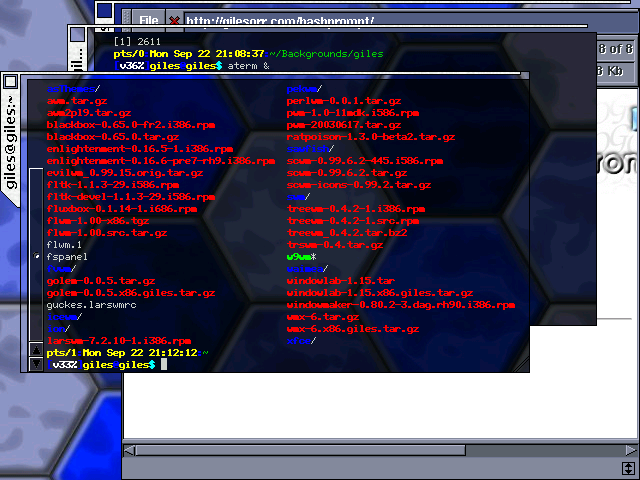WM2/WMX
WM2/WMX
- Image

Vertical titlebars and angular shaped windows are the trademark of WMX. It has extremely limited themeability: You can change the window frame and the menu (not shown) to have an image in the background, and that's where it ends.
- URL
- Version
I used version six, which has been available since April 2001. It's the most recent version.
- Documentation
One README file contains all the documentation. It seems to be fairly complete, although sparse.
- Themes
Window frames and/or the menu backgrounds can be set to a tiled image. That's the extent of WMX's themability, and, like all other changes in WMX, this can only be done by recompiling.
- Discussion
I'll admit up front that this is my favourite window manager that I never used. I've always liked the look of it. But having run it for a few days to write this report, I may well start actually using it more.
One of the most frustrating features of both these WMs (WM2 and WMX) is that a recompile is required to change even the simplest features. At least WMX supports a menu - WM2 provides you with the option to start a terminal and nothing else.
From a note on the mailing list: if your compile fails when you type "make" (after you've run "./configure" of course) edit Makefile and add "-fpermissive" to CXXFLAGS. I'm not a programmer, I don't know what it does, but it worked for me and seems to have produced a stable binary.
The author, Chris Canaam, first created a window manager called WM2. WMX is an extension of that work that supports multiple workspaces and an application menu system.
Other workspaces can be accessed by rolling the mouse wheel on the desktop, which is a fast and effective method. The sideways titlebars and shaped windows are great. The number of workspaces varies depending on your use: there's always one more than you've put windows in. ie. if I have windows in workspaces 1, 2, and 3, there will be a workspace 4 and no more. The default focus method is "Sloppy Focus," but that can be changed. The only button you get on the frame is a minimise button - although if you hold the button down for a second or two it turns into a kill button. Odd behaviour, but I rather like it - as he points out, most applications have a perfectly good exit method themselves. Menus are created by making a ~/.wmx folder with binaries and subdirs (although the submenu behaviour is a little odd - you can't back up to the main menu once you enter a submenu).
The default focus method is SloppyFocus. Keyboard support is quite good - which is good given that you'd need a recompile to change the keys you use. One fairly unusual feature of the WM is that if you change windows using the keyboard, the mouse pointer is moved to the titlebar of the new window. I actually consider this a good thing, since with SloppyFocus if the pointer is left on the previous window, then SloppyFocus is deliberately being overridden.
- Pros
Very cool look. Side titlebars. Mousewheel accesses other workspaces. Flexible focus policy. Simple. Fairly quick to learn. Extensive keyboard controls.
- Cons
Recompile required to change nearly any feature. Extremely limited themeability. Development appears to have ceased. Shaped windows mean fairly resource-hungry despite being otherwise lightweight. Only rpms I could find were version 3 - given that reconfiguring is done by recompiling, this may be just as well. Windows that attempt to occupy all workspaces will fail.
- Community
The mailing list continues to support a low level of activity.